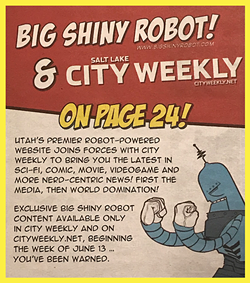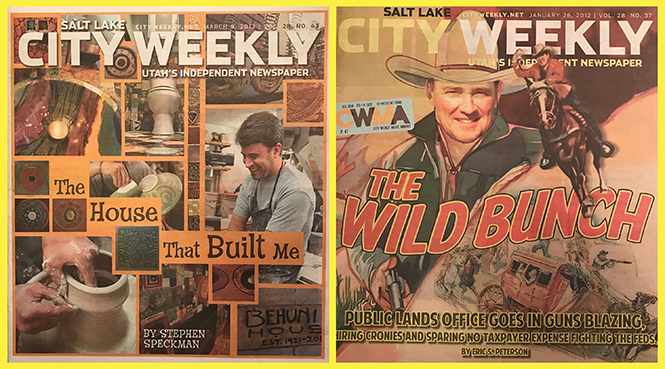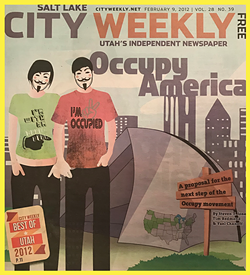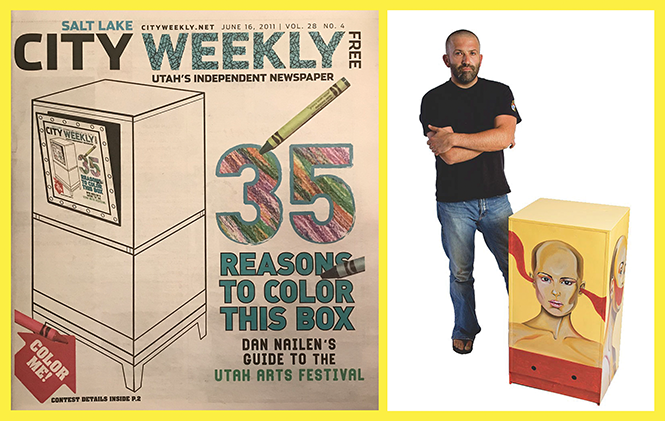"It's been my experience," wrote Jerre Wroble on May 13, 2012, "that a transatlantic journey can rearrange the fabric of one's life." Unsurprisingly, then, Wroble came home from an overseas vacation only to receive news of the impending departure of Jim Rizzi, then-publisher of City Weekly.
"Given some time working at an alt-news organization, it will leave a mark on you," Wroble observed. "And if you're lucky, you will leave a mark on it, as Jim Rizzi has done. And sometimes, you'll even make a difference, producing stories that have impact, that expose abuses of power and public trust—stories that ultimately change lives."
Rizzi's exit capped another busy year, bringing John Saltas back to active duty as publisher. And new arrivals included Bryan Young's "Big Shiny Robot" column and Colin Wolf's "Secret Handshake" blog for (as Wolf described it) "all things too awesome, pointless and inappropriate for print."
Some things aren't so beneficial, but make it into circulation anyway—like the reports then-West Valley City Mayor Mike Winder was drumming up at the Deseret News under the pseudonym "Richard Burwash." The scandal was a byproduct of CEO Clark Gilbert, whose drive for online presence put the paper's reporting, accountability and credibility in the back seat.
Such journalistic gaps were unfortunate, because they missed out on plenty of stories, like the firing of state archaeologists for alleged budgetary reasons. Said archaeologists' testimonies against a UTA train stop and mixed-use development in the footprint of a prehistoric village might have had something to do with it as well.
Elsewhere, the University of Utah joined the PAC-12, The Leonardo museum and City Creek Mall opened and political redistricting further shored up power for the state's conservatives. EnergySolutions pushed to bring "hotter" blended wastes to the state, the Uinta Basin beardtongue flower was endangered and Utah's elected leadership postured ad nauseum against the federal government over public lands.
And this does not even plumb the depths of Matthew LaPlante's story on a raid at a Hyrum meatpacking plant, Eric Peterson's guide to Mormons who diverge from conservative thought and Stephen Dark's report on Goshute efforts to save land and water at Deep Creek Valley. These were stories that had the potential to change lives. And readers didn't even need a transatlantic journey to discover them, either.
Remembering Vol. 28: In the park
"The Occupy movement that spread across the country in fall 2011 has already changed the national discussion," wrote San Francisco Bay Guardian (which closed in 2014) reporters Steven Jones, Tim Redmond and Yael Chanoff for the Feb. 9, 2012, cover story. "It's brought attention to the serious, systemic problems of gross inequities of wealth and power and the mass hardships that have resulted from that imbalance."
The initial Occupy protest sought to highlight the corrupting power of money in political systems, but subsequently broadened to encompass such issues as housing foreclosures, student debt, bank reform and jobs. Occupy groups assembled in cities across the country, Salt Lake being among them. Starting with pitched tents in Pioneer Park, Occupy SLC was forcibly relocated to Gallivan Plaza after a participant was found dead in his tent from the effects of drug use and carbon monoxide poisoning.
"Under the auspices of public-safety and public-health concerns, Mayor [Ralph] Becker and Chief [Chris] Burbank chased us all out of the park and arrested 19 of us," wrote former City Weekly journalist and Occupy SLC participant Jesse Fruhwirth on Nov. 24, 2011. "By collectively punishing the entire group ... they violated our Fourth Amendment rights by abandoning individualized suspicion."
Jim Catano, while sympathetic to Occupy's aims, pointed out flaws in the initial park arrangement in a Dec. 8 letter. "I chose to not camp because the park location did not make a statement against the corruption of the political process by big money in the way [New York City's] Wall Street camp did in the shadows of the financial institutions that tanked the economy and then got 'rewarded' for doing it with a bailout."
Occupy encampments around the country have long ago been shuttered, but their participants and wide-reaching goals remain a timely admonition for the political and economic tumult we witness today.
"The important thing," concluded Jones, Redmond and Chanoff in their Feb. 9 story, "is to let this genie out of the bottle, to move Occupy into the next level of politics, to use a convention, rally and national event to reassert the power of the people to control our political and economic institutions—and to change or abolish them as we see fit."
In the boxes
"City Weekly readers have long sought out our street boxes for what's inside: a weekly newspaper," announced Erik Daenitz in the June 23 issue of 2011. "Now, they have a new reason to look for our boxes: Public art."
Commissioning local artists, the "Out of the Box" Art Project ran promotions to get people excited about public artwork even in the most nondescript objects. Through a special "fill-in" cover for our June 16 issue, readers were even encouraged to add some color of their own to newsstands to receive tickets to the Utah Arts Festival. The artist-designed boxes were placed on display at the festival and later installed around the city for public use.
The brainchild of designer Derek Carlisle and marketing director Jackie Briggs, "Out of the Box" ran for the next five years. "We should have researched which paint stays on metal boxes so that the artist knew what medium they would be working in," Carlisle later noted. "It is a hard surface to work on to make the art last. The boxes were often put in locations that received a ton of abuse and some artists were bummed out."
Today, only a few of the artist-designed boxes remain in use. Glitches and vandalism aside, Briggs still takes great satisfaction from the overall effort. "I see some of them around town still and I just love how we were able to add more personality and art around the city," she recently wrote. "Also, it's one of those things we got to do and ask for forgiveness later [as Salt Lake City has regulations on how street boxes should look]. Turns out, the city really loved having them around town."
In the cages
"A bill working its way through the 2012 Legislature wants to take animal activists' undercover investigations of farm conditions out behind the barn and put them down for good," reported Eric Peterson on March 1. Sponsored by Rep. John Mathis, R-Vernal, HB187 criminalized the recording of factory and slaughterhouse operations.
The bill was framed, Peterson observed, by "those who see animal-rights activists as extremist groups." Indeed, the bill's Senate sponsor, Orangeville Republican David Hinkins, was explicit, saying the bill would stop "the vegetarian people," whom he compared to "terrorists."
Jeff Kerr, counsel for the national People for the Ethical Treatment of Animals (PETA), told Peterson HB187 was "an attempt to criminalize the exposing of criminal behavior." He countered the law ought to require cameras, as undercover investigations had exposed such ghastly incidents as workers kicking chickens like footballs, the pepper spraying of animals and even the sexual assault of pigs with herding canes.
"Shame on the Legislature for bowing to special interests and creating a hidden world where criminal activity and animal abuse can more safely flourish," wrote Amy Meyer in a March 15 letter. Meyer subsequently became the first person charged under the new law when she recorded images of an apparently sick cow being pushed by a bulldozer at a Draper slaughterhouse.
"I was pretty shocked at how they responded to me," Meyer told City Weekly in 2021. "I didn't think they would care at all that a 25-year-old woman on a Friday afternoon had a camera on the outside of their building. That's how threatened they are by people seeing what's happening."
Meyer challenged HB187 in court and received a broad base of support from not only animal activists, but also conservative groups and journalists, given the law's effect upon First Amendment protections.
HB187 was ultimately ruled unconstitutional in 2017, but that has not stopped Utah legislators from trying other avenues to shield animal industries from scrutiny, such as Tremonton Republican Sen. Scott Sandall's successful SB113 in 2023, which prevents counties and municipalities from enforcing any ordinance or regulation that impedes an animal enterprise. As of this writing, Rep. Walt Brooks, R-St. George, has sponsored a bill that prevents granting legal personhood (and thus recognizing any rights or privileges) to nonhuman creatures, plants or bodies of water.
More by Wes Long
-
40 Years of City Weekly—Volume 38: 2021 to 2022
City Weekly Rewind
- May 8, 2024
-
40 Years of City Weekly—Volume 37: 2020 to 2021
City Weekly Rewind
- May 1, 2024
-
40 Years of City Weekly—Volume 36: 2019 to 2020
City Weekly Rewind
- Apr 24, 2024
- More »









